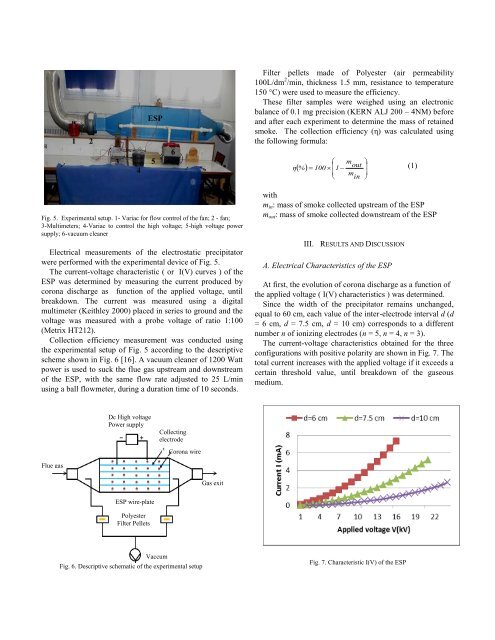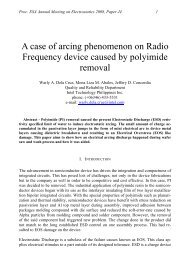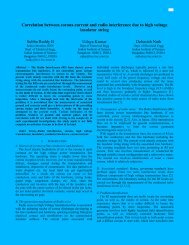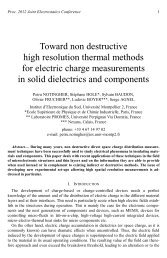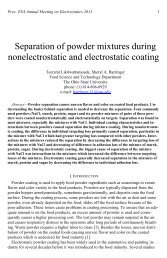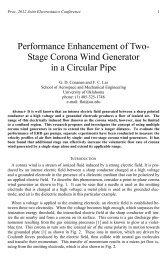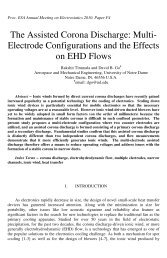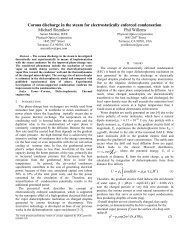Optimization of a Cost-Effective âWire-Plateâ Type ESP for ...
Optimization of a Cost-Effective âWire-Plateâ Type ESP for ...
Optimization of a Cost-Effective âWire-Plateâ Type ESP for ...
You also want an ePaper? Increase the reach of your titles
YUMPU automatically turns print PDFs into web optimized ePapers that Google loves.
1<br />
2<br />
<strong>ESP</strong><br />
3 5<br />
4<br />
6<br />
Filter pellets made <strong>of</strong> Polyester (air permeability<br />
100L/dm 2 /min, thickness 1.5 mm, resistance to temperature<br />
150 °C) were used to measure the efficiency.<br />
These filter samples were weighed using an electronic<br />
balance <strong>of</strong> 0.1 mg precision (KERN ALJ 200 – 4NM) be<strong>for</strong>e<br />
and after each experiment to determine the mass <strong>of</strong> retained<br />
smoke. The collection efficiency (η) was calculated using<br />
the following <strong>for</strong>mula:<br />
<br />
η %<br />
100 1<br />
<br />
out <br />
(1)<br />
<br />
<br />
m<br />
<br />
m <br />
in <br />
Fig. 5. Experimental setup. 1- Variac <strong>for</strong> flow control <strong>of</strong> the fan; 2 - fan;<br />
3-Multimeters; 4-Variac to control the high voltage; 5-high voltage power<br />
supply; 6-vacuum cleaner<br />
Electrical measurements <strong>of</strong> the electrostatic precipitator<br />
were per<strong>for</strong>med with the experimental device <strong>of</strong> Fig. 5.<br />
The current-voltage characteristic ( or I(V) curves ) <strong>of</strong> the<br />
<strong>ESP</strong> was determined by measuring the current produced by<br />
corona discharge as function <strong>of</strong> the applied voltage, until<br />
breakdown. The current was measured using a digital<br />
multimeter (Keithley 2000) placed in series to ground and the<br />
voltage was measured with a probe voltage <strong>of</strong> ratio 1:100<br />
(Metrix HT212).<br />
Collection efficiency measurement was conducted using<br />
the experimental setup <strong>of</strong> Fig. 5 according to the descriptive<br />
scheme shown in Fig. 6 [16]. A vacuum cleaner <strong>of</strong> 1200 Watt<br />
power is used to suck the flue gas upstream and downstream<br />
<strong>of</strong> the <strong>ESP</strong>, with the same flow rate adjusted to 25 L/min<br />
using a ball flowmeter, during a duration time <strong>of</strong> 10 seconds.<br />
with<br />
m in : mass <strong>of</strong> smoke collected upstream <strong>of</strong> the <strong>ESP</strong><br />
m out : mass <strong>of</strong> smoke collected downstream <strong>of</strong> the <strong>ESP</strong><br />
III. RESULTS AND DISCUSSION<br />
A. Electrical Characteristics <strong>of</strong> the <strong>ESP</strong><br />
At first, the evolution <strong>of</strong> corona discharge as a function <strong>of</strong><br />
the applied voltage ( I(V) characteristics ) was determined.<br />
Since the width <strong>of</strong> the precipitator remains unchanged,<br />
equal to 60 cm, each value <strong>of</strong> the inter-electrode interval d (d<br />
= 6 cm, d = 7.5 cm, d = 10 cm) corresponds to a different<br />
number n <strong>of</strong> ionizing electrodes (n = 5, n = 4, n = 3).<br />
The current-voltage characteristics obtained <strong>for</strong> the three<br />
configurations with positive polarity are shown in Fig. 7. The<br />
total current increases with the applied voltage if it exceeds a<br />
certain threshold value, until breakdown <strong>of</strong> the gaseous<br />
medium.<br />
Flue gas<br />
Dc High voltage<br />
Power supply<br />
Collecting<br />
electrode<br />
Corona wire<br />
Exit to a<br />
Chimney<br />
Gas exit<br />
<strong>ESP</strong> wire-plate<br />
Polyester<br />
Filter Pellets<br />
Vaccum<br />
Fig. 6. Descriptive schematic <strong>of</strong> the pump experimental setup<br />
Fig. 7. Characteristic I(V) <strong>of</strong> the <strong>ESP</strong>


